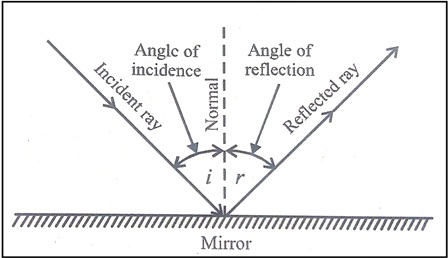Laws of Reflection











Laws of Reflection
It is found that the reflection of light, from a Surface, always take place in a well defined manner according to the rules. We call these two rules as the two laws of reflection. We must, however, first know some terms to understand and explain the two laws of reflection.
(i) The ‘Point of incidence’ and the ‘Normal’: The Point of incidence is that point on the Surface of the mirror where the incident ray falls. A line Perpendicular to the Surface, at the Point of incidence, is known as the ‘Normal.’
(ii) The incident ray and the Reflected ray:The ray of light, coming towards the mirror, is called the incident ray. Similarly, the ray of light, which turns back after ‘reflection’ from the mirror Surface, is called the reflected ray.
(iii) Angle of incidence and Angle of Reflection:The angle between the incident ray and the normal at the point of incidence, is known as the angle of incidence. Similarly, the angle between the normal and the reflected ray, at the point of incidence, is called angle of Reflection
.

(iv) The Plane of incidence and the Plane of Reflection: The Plane, defined by the incident ray and the normal, at the point of incidence, is called the Plane of incidence. Similarly, the plane defined by the reflected ray and the normal, at the point of incidence, is called the plane of reflection.
First Law:
The incident ray, the normal at the point of incidence and the reflected ray, all lie in the same Plane.
Second Law:
The angle of incidence and the angle of reflection are equal to each other.
Illustration: The incident ray makes an angle of 30 degree with the normal. Find the angle of reflection.
Solution: Given, the angle of incidence
According to the laws of reflection
Therefore
Illustration: The incident ray makes an angle of 30 degree with the surface. Find the angle of reflection.
Solution: Given, the ray makes an angle of 30 degree with the surface
And we know the normal makes an angle of with the surface.

From the figure:
angle of incidence
According to the laws of reflection
Therefore
Note: When the ray of light falls normally or perpendicular on the surface of a plane mirror.
Then the angle of incidence is
According to the laws of reflection
So
Hence the ray which is incident normally on a mirror is reflected back along the same path.
The incident ray, the reflected ray and the normal lie on the same________________ | |||
| Right Option : C | |||
| View Explanation | |||
The ray of light, coming towards the mirror, is called the _______________________ . | |||
| Right Option : C | |||
| View Explanation | |||
The angle of incidence in a plane mirror is _______ angle of reflection. | |||
| Right Option : A | |||
| View Explanation | |||
Students / Parents Reviews [10]
It has a great methodology. Students here can get analysis to their test quickly.We can learn easily through PPTs and the testing methods are good. We know that where we have to practice

Barkha Arora
10thAbhyas is a complete education Institute. Here extreme care is taken by teacher with the help of regular exam. Extra classes also conducted by the institute, if the student is weak.

Om Umang
10thIt was good as the experience because as we had come here we had been improved in a such envirnment created here.Extra is taught which is beneficial for future.

Eshan Arora
8thAbout Abhyas metholodology the teachers are very nice and hardworking toward students.The Centre Head Mrs Anu Sethi is also a brilliant teacher.Abhyas has taught me how to overcome problems and has always taken my doubts and suppoeted me.

Shreya Shrivastava
8thBeing a parent, I saw my daughter improvement in her studies by seeing a good result in all day to day compititive exam TMO, NSO, IEO etc and as well as studies. I have got a fruitful result from my daughter.

Prisha Gupta
8thMy experience with Abhyas is very good. I have learnt many things here like vedic maths and reasoning also. Teachers here first take our doubts and then there are assignments to verify our weak points.

Shivam Rana
7thI have spent a wonderful time in Abhyas academy. It has made my reasoning more apt, English more stronger and Maths an interesting subject for me. It has given me a habbit of self studying

Yatharthi Sharma
10thA marvelous experience with Abhyas. I am glad to share that my ward has achieved more than enough at the Ambala ABHYAS centre. Years have passed on and more and more he has gained. May the centre flourish and develop day by day by the grace of God.

Archit Segal
7thIt was a good experience with Abhyas Academy. I even faced problems in starting but slowly and steadily overcomed. Especially reasoning classes helped me a lot.

Cheshta
10thOne of the best institutes to develope a child interest in studies.Provides SST and English knowledge also unlike other institutes. Teachers are co operative and friendly online tests andPPT develope practical knowledge also.
